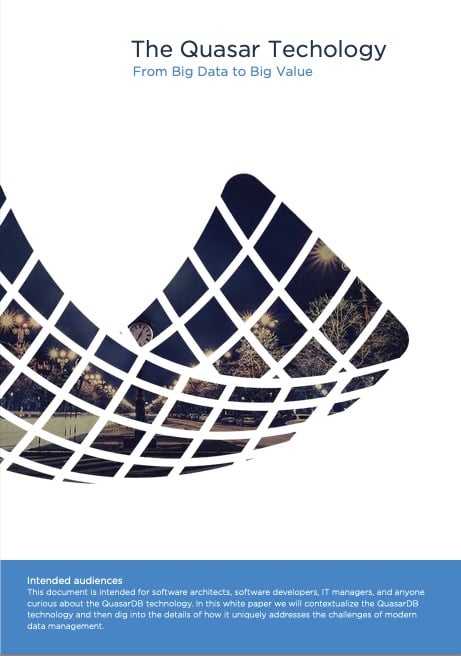QuasarDB.
The database designed
for real-time intel.
Quasar is a time-series database optimized for large volumes and low latency. It combines the speed of in-memory database with the yield of data warehouses.
Thanks to its unique compression, clustering, and indexing innovations, Quasar delivers unprecedented performance with a small footprint.
Whether you need speed or volume, Quasar delivers.
QuasarDB Key Features
Instant ad-hoc querying
Data stored in QuasarDB can be queried ad-hoc, using SQL, at blazing speed. Built-in enhanced analytics and time management features make you even more productive.
Outstanding compression
QuasarDB delivers the best time-series compression thanks to its AI-powered Delta4C compression algorithm suite.
Streaming analytics
QuasarDB supports streaming analytics with aggregated tables. Data is aggregated as it comes, further reducing storage footprint and delivering ultra-low latency querying and analysis.
Unlimited Ingestion
The dedicated ingestion API delivers the highest ingestion rate on the market with instant data visibility. Deduplication, truncation, upsert: all possible modes are supported.
Scale-up and out
Support for a wide range of storage options that can be tiered: attached drives, remote drives, and S3-compatible object storage.
Lightweight, efficient
With ultra-efficient low-level implementation and a small footprint, QuasarDB is at ease in the data center or at the edge.
Endless storage
Support for a wide range of storage options that can be tiered: attached drives, remote drives, and S3-compatible object storage.
Easy integration and deployment
Native support for Intel and ARM architectures. A wide range of integration is available out of the box. QuasarDB supports SQL, Pandas, ODBC, .NET, and much more!
Advanced security
Stay compliant and secure with QuasarDB: cryptographically strong authentication, fine-grained access control, audit trail, and in-depth security design. Learn more.
Technology Whitepaper

Deployments
Cloud
Cloud deployments as SaaS (Software as a Service) and PaaS (Platform as a Service) are available. Quasar has official virtual machine images for Amazon AWS and Microsoft Azure. Other mainstream cloud platforms are also supported. Instances can run either within your account or QuasarDB’s, with the option of being fully managed.

Edge
Supporting all QuasarDB features, QuasarDB Edge is a lightweight, self-contained database solution optimized for embedded devices. It carries the same functionalities and benefits as QuasarDB, simply in a small package with low resource requirements. Available as OEM.

On-premises
Experience the full power of QuasarDB on-premises: run QuasarDB on your infrastructure. It is preferred by organizations requiring complete data control, have specific security or compliance requirements, or use cases with limited internet connectivity.

